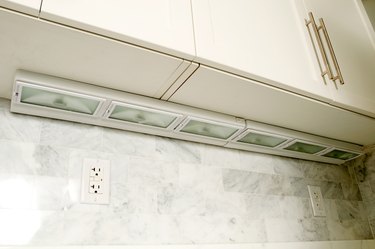 Light strips consist of several low-wattage bulbs. Image Credit: Jupiterimages/Photos.com/Getty Images
Light strips consist of several low-wattage bulbs. Image Credit: Jupiterimages/Photos.com/Getty Images
Electricians refer to wire thickness according to a unit of measurement called gauge, which represents a wire's diameter. Wires with large gauges are thinner than wires with small gauges. Under-cabinet lights aren't standardized products; their wiring requirements vary according to the type of lamps they use and the voltage of the fixture. An understanding of common under-cabinet light fixtures helps you choose the right electrical supplies for your project.
Video of the Day
Types of Under-Cabinet Lights
Your under-cabinet lighting project's wiring requirements vary according to the type of light fixture that you plan to install. Under-cabinet lights are available with incandescent, fluorescent and LED bulbs. Incandescent lights are a traditional choice. Although inexpensive and widely available, incandescent bulbs have a relatively short lifespan. Fluorescent lights generally last longer and cost less to operate than incandescent bulbs, but consist of more expensive, complex hardware, such as ballasts. While LED under-cabinet lights usually require the largest initial investment, they typically last longer and use less energy than incandescent and fluorescent lights.
Corded Vs. Hard-Wired
All types of under-cabinet lights are available in hard-wired or corded models. In hard-wired installations, a concealed cable routes power through a switch and to the light fixture. Corded under-cabinet lights have a pronged power cord that plugs into a countertop outlet. Corded units are easier to install than hard-wired units, but their power cords tend to clutter the countertop. If you choose a corded under-cabinet light kit, the manufacturer usually includes the power cord and installation hardware with the light fixture.
Wire Gauge for Hard-Wired Projects
Although wire size ultimately depends on your light-fixture manufacturer's specifications, 12-gauge wire is standard for most incandescent and fluorescent under-cabinet fixtures. A basic installation requires a 12-2 NM cable. Twelve refers to the wire's gauge, 2 refers to the number of conductive wires and NM stands for non-metallic sheathed cable. Many cable manufacturers follow a standardized, color-coding scheme for their residential wire. According to the color-coding scheme, 12 gauge cable has a yellow sheathe. Older wire might not follow the modern scheme; check your wire's stamp to determine the gauge. Note that the specifics of your electrical system might affect the required wire size, including the length of the cable's run and the number of fixture on the circuit.
Low-Voltage LED Lights
LED lights often run on low-voltage power. The LED lighting system includes a transformer that converts the residential current to a lower voltage. Electrical cable connects to the transformer before routing to the LED light fixture. In most cases, a 14 gauge cable is suitable for wiring an LED fixture transformer. However, as with incandescent and fluorescent fixtures, the right wire size for the job depends on the layout of your home's electrical circuits and the light fixture manufacturer's specifications.



























